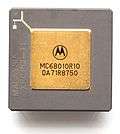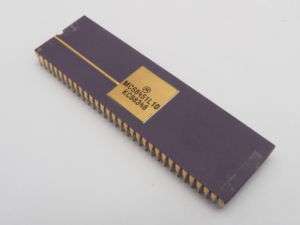Motorola 68010
The Motorola MC68010 processor is a 16/32-bit microprocessor from Motorola, released in 1982 as the successor to the Motorola 68000.[1] It fixes several small flaws in the 68000, and adds a few features.


The 68010 was pin-compatible with the 68000, but was not 100% software compatible. Some of the differences were:
- The MOVE from SR instruction is now privileged (it may only be executed in supervisor mode). This means that the 68010 meets Popek and Goldberg virtualization requirements. Because the 68000 offers an unprivileged MOVE from SR, it does not meet them.
- The MOVE from CCR instruction was added to partially compensate for the removal of the user-mode MOVE from SR.
- It can recover from bus faults, allowing it to implement virtual memory.
- The exception stack frame is different.
- It introduced a 22-bit Vector Base Register (VBR) that holds A[31:10] of the 1 KiB-aligned base address for the exception vector table. The 68000 vector table was always based at address zero.
Additionally, the 68010 had a "loop mode" which accelerates loops consisting of only two instructions, such as a MOVE and a DBRA. The two-instruction mini-loop opcodes are prefetched in the 6-Byte instruction cache while memory read/write cycles are only for the data operands. It provided for performance improvements averaging 50%, as a result of the elimination of instruction opcodes fetching.
In practice, the overall speed gain over a 68000 at the same frequency was less than 10%.

The 68010 could be used with the 68451 MMU. However, aspects of its design, such as its 1 clock memory access penalty, made this configuration unpopular. Some vendors used their own MMU designs, such as Sun Microsystems in their Sun-2 workstation and AT&T UNIX PC/3B1.
The 68010 was never as popular as the 68000. However, due to the 68010's small speed boost over the 68000 and its support for virtual memory, it can be found in a number of smaller Unix systems, both with the 68451 MMU (for example in the Torch Triple X), and with a custom MMU (such as the Sun-2 Workstation, AT&T UNIX PC/3B1, Convergent Technologies MiniFrame, the NCR Tower XP and early HP 9000s like the Model 300 and 310) and various research machines. Most other vendors stayed with the 68000 until the 68020 was introduced. Some owners of Amiga and Atari ST computers and Sega Genesis game consoles replaced their system's 68000 CPU with a 68010 to gain a small speed boost.[2]